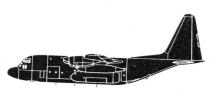
ASN Wikibase Occurrence # 319189
| Date: | Thursday 23 April 2020 |
| Time: | 17:24 |
| Type: |  Lockheed C-130J-30 Super Hercules |
| Owner/operator: | United States Air Force - USAF |
| Registration: | 11-5736 |
| MSN: | 5736 |
| Year of manufacture: | 2013 |
| Total airframe hrs: | 4624 hours |
| Engine model: | Rolls-Royce AE2100D3 |
| Fatalities: | Fatalities: 0 / Occupants: 4 |
| Aircraft damage: | Substantial |
| Category: | Accident |
| Location: | Ramstein AFB (RMS) -
 Germany Germany
|
| Phase: | Landing |
| Nature: | Military |
| Departure airport: | Ramstein AFB (RMS/ETAR) |
| Ramstein AFB (RMS/ETAR) | |
| Investigating agency: | USAF AIB |
| Confidence Rating: |
The C-130J-30, assigned to the 37th Airlift Squadron, 86th Airlift Wing at Ramstein Air Base, Germany, conducted a routine periodic evaluation flight for a pilot.
The crew flew a maximum effort (assault) landing at Ramstein Air Base and experienced a hard landing with a vertical acceleration load factor (g-load) exceedance value of 3.62 times the force of gravity (g) and a landing sink rate of 834 feet per minute exceeding the aircrafts maximum allowable landing limits of 540 fpm and g-load of 2.0g. Immediately upon touchdown, the crew executed a go-around and coordinated with Air Traffic Control for a visual approach, full-stop landing. The aircraft landed safely at 17:37.
The landing g-load exceedance resulted in significant damage to the center wing, both outer wings, left and right main landing gear assemblies, and engines, to include mounting structures. The estimated damages are $20,917,089.
The crew of this mission was scheduled to fly in a formation of three C-130Js planning to conduct two training routes. The primary training objective for the local sortie was to complete the pilots evaluation. The crew planned to takeoff early as a single-ship, conduct a maximum effort takeoff followed by a maximum effort landing using the painted landing zone marked on the runway as required for the evaluation, full-stop, and then rejoin the formation in order to complete the remainder of the evaluation requirements in the formation. Preflight, engine start, taxi and the Ramstein AB visual traffic pattern procedures were executed within good flying standards and were procedurally correct. The mishap occurred during the maximum effort landing.
The Accident Investigation Board President found, by a preponderance of the evidence, the cause of this mishap was the pilot's early engine power reduction (power pull), beginning at 70 feet above ground level (AGL) and fully flight idle at 45 feet AGL. In addition, the board president found, by the preponderance of evidence, that the evaluated pilot and other pilots failure to identify the excessive sink rate and their failure to arrest the excessive sink rate or go-around in a timely manner were substantially contributing factors that resulted in the aircraft exceeding the C-130J-30 g-load and sink rate landing limits.
Accident investigation:
 |
|
Sources:
Location
Images:

photo (c) USAF AIB; Ramstein AFB (RMS); April 2020

photo (c) USAF AIB; Ramstein AFB (RMS); April 2020
Revision history:
| Date/time | Contributor | Updates |
|---|
The Aviation Safety Network is an exclusive service provided by:


 ©2024 Flight Safety Foundation
©2024 Flight Safety Foundation